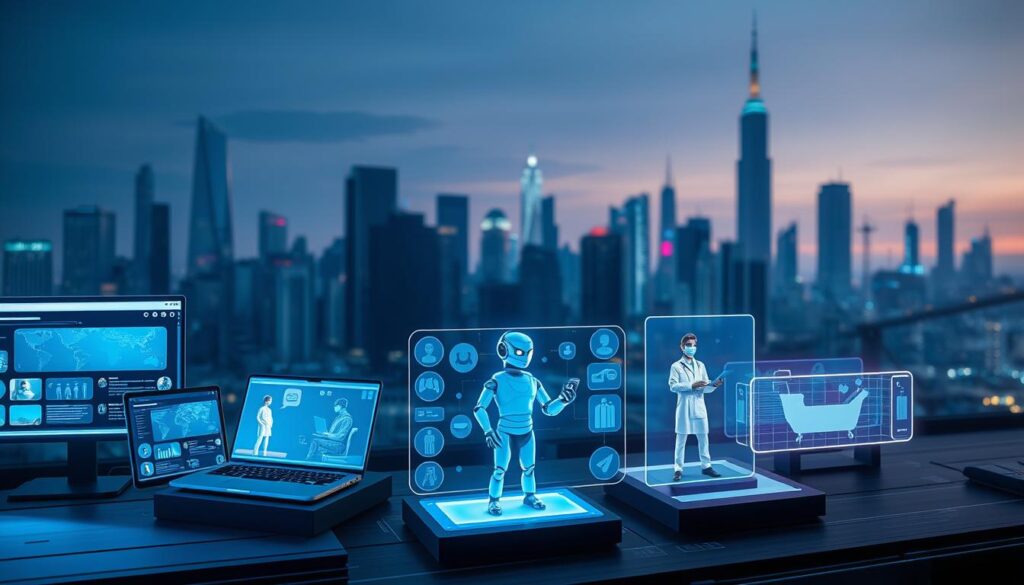Are businesses leveraging the full potential of artificial intelligence to revolutionize their customer service and lead generation processes?
As a conversational AI platform, we help customers harness the power of AI-driven chatbot capabilities to provide fast, automated customer service. This transformative technology is changing how businesses interact with their customers, making it more efficient and personalized.
The integration of AI in chatbot technology is not just a trend; it’s a significant shift in how businesses approach customer engagement. By leveraging AI, companies can offer 24/7 customer support, improve response times, and enhance customer experience.
Key Takeaways
- AI-driven chatbots are revolutionizing customer service.
- Businesses can benefit from 24/7 automated support.
- AI chatbots improve response times and customer experience.
- The use of AI in chatbots is a significant business trend.
- Personalization is a key advantage of AI chatbot technology.
The Evolution of Chatbot Technology
From rudimentary beginnings to the current state of AI-powered chatbots, the evolution of chatbot technology is a story of rapid innovation. Early chatbots were limited by their reliance on scripted responses and rule-based systems, but the advent of machine learning and neural networks has enabled the development of more sophisticated conversational agents.
Early Rule-Based Chatbots
The first generation of chatbots operated on rule-based systems, where interactions were governed by predefined rules and scripts. These chatbots were capable of responding to specific user inputs based on the rules programmed into their systems. However, they lacked the ability to understand the nuances of human language and were limited in their capacity to engage in complex conversations.
Despite their limitations, early rule-based chatbots laid the groundwork for the development of more advanced chatbot technologies. They were used in various applications, including customer service and tech support, providing a basic level of automation and efficiency.
The Shift to AI-Powered Conversational Agents
The introduction of artificial intelligence (AI) and machine learning marked a significant turning point in the evolution of chatbot technology. AI-powered conversational agents are capable of learning from user interactions, adapting their responses to provide more personalized and relevant conversations. This shift has enabled chatbots to become more effective in understanding and responding to user queries.
For a deeper dive into the role of AI in chatbots, you can explore The Evolution of Chatbots: A Deep Dive into. This resource provides further insights into how AI is transforming chatbot technology.
How AI is Revolutionizing Chatbot Capabilities
AI is transforming chatbot capabilities, enabling more sophisticated and personalized user experiences. This transformation is driven by advancements in natural language processing (NLP) and machine learning algorithms, which allow chatbots to understand and respond to user queries more effectively.
From Scripted Responses to Intelligent Conversations
Traditional chatbots were limited by their scripted responses, which often led to a static and unengaging user experience. In contrast, AI-powered chatbots can engage in dynamic conversations, adapting to the context and nuances of user inputs. This shift towards intelligent conversations is made possible by machine learning chatbots that learn from past interactions and improve over time.
Natural Language Processing Breakthroughs
NLP has been a crucial factor in the evolution of chatbot technology. Recent breakthroughs in NLP have enabled chatbots to better comprehend the complexities of human language, including idioms, colloquialisms, and context-dependent expressions. This advancement has significantly enhanced the ability of chatbots to provide accurate and relevant responses to user queries.
- Improved language understanding
- Enhanced contextual awareness
- Better handling of ambiguous queries
Context Awareness and Memory in Modern Chatbots
One of the key advanced chatbot features is the ability to maintain context awareness and memory throughout a conversation. This capability allows chatbots to recall previous interactions and tailor their responses accordingly, creating a more personalized and engaging experience for users.
By leveraging AI and machine learning, modern chatbots can now offer contextual understanding that was previously unimaginable. This not only improves user satisfaction but also increases the efficiency of chatbot interactions.
Core AI Technologies Powering Modern Chatbots
At the heart of contemporary chatbot development are several key AI technologies that enable these systems to understand, learn, and interact with users effectively.
The integration of various AI technologies has transformed chatbots from simple rule-based systems to sophisticated conversational agents capable of handling complex interactions. Machine learning algorithms play a crucial role in this transformation, allowing chatbots to learn from data and improve their responses over time.
Machine Learning Algorithms in Chatbot Development
Machine learning is a subset of AI that involves training algorithms on data to enable machines to make predictions or decisions without being explicitly programmed. In chatbot development, machine learning algorithms are used to:
- Analyze user inputs to understand intent and context
- Generate relevant and accurate responses
- Continuously improve the chatbot’s performance based on user interactions
Deep Learning and Neural Networks
Deep learning, a subset of machine learning, utilizes neural networks to analyze complex patterns in data. In the context of chatbots, deep learning enables:
- More accurate understanding of natural language
- Generation of human-like responses
- Improved contextual understanding, allowing for more coherent conversations
Sentiment Analysis and Emotional Intelligence
Modern chatbots are increasingly incorporating sentiment analysis and emotional intelligence to provide more empathetic and personalized interactions. This involves:
- Recognizing user emotions through text or voice analysis
- Adjusting responses to match the user’s emotional state
- Providing support that is not only informative but also emotionally resonant
By leveraging these advanced AI technologies, modern chatbots are capable of delivering more sophisticated, engaging, and effective user experiences.
Advanced Features of AI-Driven Chatbots
Modern chatbots powered by AI are not just simple query responders; they are now equipped with advanced capabilities that make interactions more natural and personalized. These advancements have transformed the way businesses interact with their customers, providing more efficient and effective support.
Multilingual Capabilities
One of the significant advantages of AI-driven chatbots is their ability to support multiple languages. This feature allows businesses to cater to a global audience, breaking down language barriers and expanding their reach. Multilingual chatbots can understand and respond in various languages, making them an invaluable tool for international businesses.
- Enable global customer support without language constraints
- Improve user experience for non-native English speakers
- Enhance brand reputation by catering to diverse linguistic demographics
Voice Recognition and Speech Synthesis
The integration of voice recognition and speech synthesis technologies has further enhanced the capabilities of AI chatbots. These features allow chatbots to understand spoken language and respond in a natural, human-like voice, creating a more intuitive and engaging user experience.
- Voice recognition enables users to interact with chatbots using spoken commands
- Speech synthesis provides auditory responses, making interactions more accessible
- Combining these technologies creates a seamless voice-based interaction
Personalization and User Profiling
AI-driven chatbots can also offer personalized experiences through user profiling. By analyzing user data and interaction history, chatbots can tailor their responses to individual preferences, creating a more engaging and relevant experience for each user.
The key benefits of personalization include:
- Improved user engagement through relevant responses
- Enhanced customer satisfaction by addressing individual needs
- Increased loyalty by providing a tailored experience
Enhancing Customer Service with Chatbots
Chatbots, powered by AI, are redefining customer service by offering instant responses and personalized experiences. This transformation is crucial in today’s fast-paced business environment, where customer expectations are continually evolving.
24/7 Availability and Instant Response
One of the significant advantages of AI chatbots is their ability to provide 24/7 availability to customers. This means that customers can get answers to their questions or assistance with their issues at any time of the day, leading to increased customer satisfaction and loyalty.
Instant responses are critical in maintaining customer engagement. AI chatbots can process and respond to customer inquiries in real-time, reducing the wait time that is typically associated with human customer support.
Handling Complex Customer Inquiries
Advanced AI chatbots are capable of handling complex customer inquiries by leveraging natural language processing (NLP) and machine learning algorithms. This enables them to understand the nuances of customer queries and provide relevant solutions.
By handling complex inquiries effectively, businesses can reduce the workload on human customer support agents, allowing them to focus on more critical issues that require a personal touch.
Integration with CRM Systems
The integration of AI chatbots with Customer Relationship Management (CRM) systems is a game-changer in customer service. This integration enables chatbots to access customer data, providing personalized support and improving the overall customer experience.
By leveraging CRM data, chatbots can offer tailored recommendations, resolve issues more efficiently, and enhance customer engagement.
Measuring ROI of AI Chatbot Solutions
To understand the effectiveness of AI chatbot solutions, businesses need to measure their return on investment (ROI). Key metrics for measuring ROI include customer satisfaction ratings, reduction in support queries, and increase in sales or conversions.
By analyzing these metrics, businesses can refine their chatbot strategies, making data-driven decisions to improve customer service and drive business growth.
AI Chatbot Solutions Across Different Industries
AI chatbots are being increasingly adopted across multiple sectors, revolutionizing customer engagement and operational efficiency. This widespread adoption is a testament to the versatility and effectiveness of AI chatbot solutions in addressing diverse industry needs.

E-commerce and Retail Applications
In the e-commerce and retail sectors, AI chatbots are enhancing customer experience by providing personalized product recommendations, facilitating order tracking, and offering 24/7 customer support. These chatbots use machine learning algorithms to analyze customer behavior and preferences, enabling retailers to tailor their services and improve sales.
For instance, a customer can inquire about product availability, and the chatbot can not only provide the information but also suggest related products based on the customer’s past purchases and browsing history. This level of personalization is made possible by advanced AI chatbot technology, which is transforming the retail landscape.
Healthcare Chatbots
In healthcare, AI chatbots are being used to provide patients with immediate responses to their queries, appointment scheduling, and medication reminders. These chatbots can also assist in symptom checking and offer basic medical advice, thereby reducing the workload on healthcare professionals and improving patient care.
Healthcare chatbots are designed to handle sensitive information securely, adhering to privacy regulations such as HIPAA. By leveraging natural language processing (NLP), these chatbots can understand and respond to complex medical queries, providing support and guidance to patients.
Financial Services and Banking
The financial services and banking sectors are utilizing AI chatbots to enhance customer service, provide account information, and facilitate transactions. These chatbots can assist with tasks such as balance inquiries, transaction history, and fund transfers, making banking services more accessible and convenient.
Moreover, AI chatbots in finance are being used for fraud detection and alerting customers to suspicious activities. By analyzing transaction patterns and behavior, these chatbots can help prevent financial fraud and protect customer assets.
Education and Learning Assistance
In education, AI chatbots are emerging as valuable tools for learning assistance, providing students with support in their studies, and helping educators with administrative tasks. These chatbots can offer personalized learning recommendations, assist with course enrollment, and provide answers to frequently asked questions.
Educational chatbots can also facilitate interactive learning experiences, making complex concepts more engaging and accessible. By leveraging AI-driven adaptive learning, these chatbots can tailor educational content to individual students’ needs, enhancing the learning experience.
Challenges and Limitations in AI Chatbot Development
The journey of AI chatbot development is marked by significant achievements and notable challenges alike. As we continue to push the boundaries of what chatbots can do, it’s essential to address the hurdles that developers and businesses face in implementing these technologies effectively.
Understanding Complex Human Language
One of the primary challenges in AI chatbot development is understanding complex human language. Human communication is nuanced, with context, idioms, and subtle cues that can be difficult for AI systems to grasp fully. Natural Language Processing (NLP) has made significant strides, but there’s still a gap between human understanding and AI interpretation.
To overcome this, developers are focusing on improving NLP capabilities through advanced machine learning algorithms and larger, more diverse training datasets. This includes teaching chatbots to recognize sarcasm, humor, and other complex linguistic elements that are often misinterpreted.
Ethical Considerations and Privacy Concerns
As AI chatbots become more integrated into our daily lives, ethical considerations and privacy concerns come to the forefront. There’s a delicate balance between providing personalized experiences and respecting user privacy. Data protection and transparency in AI decision-making are critical areas that require careful consideration.
- Ensuring compliance with data protection regulations like GDPR and CCPA
- Implementing robust security measures to protect user data
- Being transparent about how user data is used and processed
Technical Limitations and Integration Issues
Technical limitations and integration issues also pose significant challenges. Integrating AI chatbots with existing systems, such as CRM software or legacy databases, can be complex and resource-intensive. Moreover, ensuring seamless interaction across different platforms and devices is crucial for a cohesive user experience.
To address these challenges, developers are working on creating more flexible and adaptable chatbot architectures. This includes using API-driven development to facilitate easier integration with various systems and services.
The Future of Chatbot Development
Emerging trends in AI are redefining the landscape of chatbot development. As businesses continue to adopt AI-powered chatbots, the technology is evolving to offer more sophisticated and personalized interactions. The future of chatbot development is characterized by advancements in multimodal interactions, voice-enabled bots, and the integration of generative AI.
Emerging Trends in AI Chatbot Technology
The chatbot landscape is witnessing significant shifts driven by AI advancements. Some of the key trends include:
- Enhanced Personalization: AI algorithms are being used to create highly personalized chatbot interactions based on user data and behavior.
- Voice-Enabled Bots: The integration of voice recognition technology is enabling more natural and intuitive interactions with chatbots.
- Multimodal Interactions: Chatbots are evolving beyond text-based interactions to include voice, visual, and gesture-based interfaces.
Multimodal Chatbots: Beyond Text Interactions
Multimodal chatbots represent a significant leap forward in chatbot technology. By incorporating various interaction modes, such as voice, text, and visual elements, these chatbots can provide a more engaging and flexible user experience. For instance, a customer can initiate a conversation via text and then seamlessly transition to a voice call, all within the same interface.

The Role of Generative AI in Next-Generation Chatbots
Generative AI is set to play a pivotal role in the next generation of chatbots. By leveraging generative models, chatbots can produce more dynamic and contextually relevant responses, enhancing the overall user experience. This technology enables chatbots to move beyond pre-defined responses and engage in more meaningful and creative conversations.
As chatbot technology continues to evolve, businesses that adopt these emerging trends will be well-positioned to deliver exceptional customer experiences and stay ahead of the competition.
Conclusion
As we’ve explored throughout this article, AI is revolutionizing chatbot capabilities, enabling businesses to provide more personalized and efficient customer service. By leveraging AI chatbot technology, companies can enhance customer experiences, streamline operations, and gain a competitive edge in their respective markets. For instance, AI-powered chatbots can automate routine customer inquiries, freeing up human customer service representatives to focus on more complex issues.
Enhancing customer service with chatbots is a key benefit of AI chatbot technology. With the ability to provide 24/7 support, chatbots can significantly improve customer satisfaction and loyalty. To learn more about how AI tools can help small businesses enhance customer service, you can visit this resource for additional insights.
By embracing AI chatbot technology, businesses can unlock new opportunities for growth and success. As the technology continues to evolve, we can expect to see even more innovative applications of AI chatbots across various industries.
FAQ
How is AI revolutionizing chatbot capabilities?
AI is transforming chatbot technology by enabling machines to understand and respond to human language more effectively, shifting from scripted responses to intelligent conversations, and incorporating advancements in NLP and context awareness.
What are the core AI technologies powering modern chatbots?
The core AI technologies powering modern chatbots include machine learning algorithms, deep learning, neural networks, sentiment analysis, and emotional intelligence, which collectively contribute to the advanced capabilities of AI chatbots.
How do AI chatbots enhance customer service?
AI chatbots enhance customer service by offering 24/7 availability, handling complex inquiries, integrating with CRM systems, and providing personalized experiences, ultimately leading to improved customer satisfaction and reduced support costs.
What are the advanced features of AI-driven chatbots?
Advanced features of AI-driven chatbots include multilingual capabilities, voice recognition and speech synthesis, and personalization through user profiling, allowing businesses to cater to diverse customer needs and preferences.
What are the challenges faced in AI chatbot development?
Challenges in AI chatbot development include understanding complex human language, addressing ethical and privacy concerns, and overcoming technical integration issues, which require careful consideration and strategic planning.
How are AI chatbot solutions being applied across different industries?
AI chatbot solutions are being applied in various industries, including e-commerce, healthcare, finance, and education, to improve customer engagement, streamline processes, and drive business success.
What is the future of chatbot development?
The future of chatbot development is expected to be shaped by emerging trends such as multimodal chatbots, advancements in voice technology, and the role of generative AI in next-generation chatbots, leading to more sophisticated and human-like interactions.
How do machine-learning chatbots differ from traditional chatbots?
Machine learning chatbots differ from traditional chatbots in their ability to learn from data and improve over time, enabling more accurate and context-aware responses, whereas traditional chatbots rely on pre-defined rules and scripts.
What is the role of NLP in AI chatbot technology?
NLP plays a crucial role in AI chatbot technology by enabling machines to understand, interpret, and generate human language, facilitating more effective and natural interactions between humans and chatbots.








